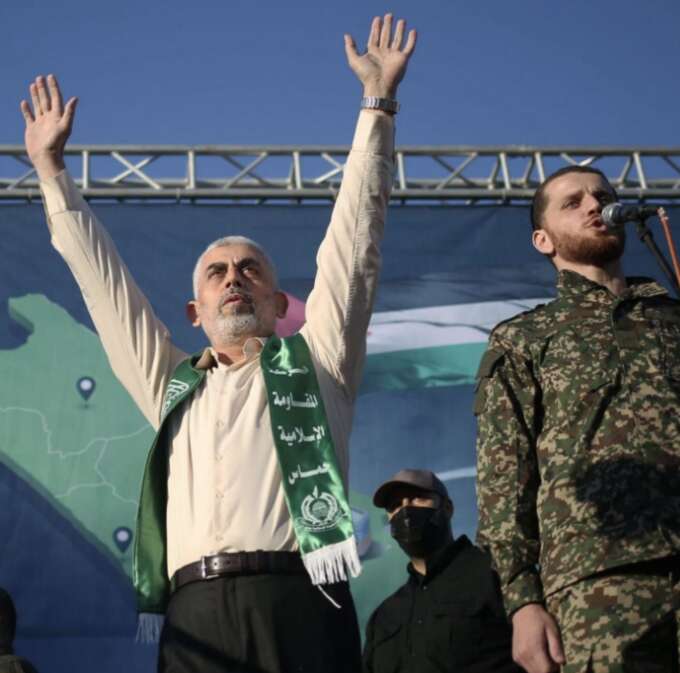A roadmap without a road: Why the "Biden Deal" for Gaza fell through
Israeli Prime Minister Benjamin Netanyahu has dissolved the war cabinet he formed following the Hamas terrorist attack of October 7.
Before he did so, two of its members — Benny Gantz and Gadi Eisenkot, each of whom previously served as Chief of the General Staff of the Israeli Defense Forces — resigned from the political body. Both Gantz and Eisenkot were advocates of the “Biden deal,” which proposes a temporary ceasefire and a partial withdrawal of Israeli troops from the Gaza Strip in exchange for the release of Israeli hostages. Professor Zeev Khanin of Bar-Ilan University outside Tel Aviv explains that while most Israelis likewise support the “Biden deal,” its implementation has faced numerous obstacles. These include the right-wing Israeli governing coalition’s desire to complete the military operation, and also Hamas’s lack of interest in upholding its end of the bargain.
The coalition collapses
One week after several members of Israel’s war cabinet resigned, Benjamin Netanyahu announced the body’s dissolution. The “wartime cabinet” was formed on October 11, 2023, to manage military operations in Gaza following the Hamas terrorist attack of October 7. In addition to Netanyahu and his Defense Minister Yoav Gallant, it included two respected Netanyahu critics: retired generals Benny Gantz and Gadi Eisenkot, each of whom served as Chief of the General Staff of the Israeli Defense Forces (IDF) before entering politics as part of the centrist National Unity alliance, which holds 8 of the Knesset’s 120 total seats. Their inclusion was meant to demonstrate national solidarity.
In the immediate aftermath of October 7, Gantz and Eisenkot did indeed exert some influence, balancing out the weight of the cabinet’s far-right faction. According to some commentators, in the early weeks of the war, the retired generals managed avert a full-scale regional conflict by thwarting an almost finalized plan for a preemptive strike on Lebanese Hezbollah. They also convinced Netanyahu to agree to a week-long truce with Hamas, during which 105 Israeli hostages — mostly women and children — were returned from Gaza.
However, in the prime minister’s office, Gantz was viewed as a sort of “special envoy” for Joe Biden and a “lobbyist” for the American president’s approach to resolving the conflict. It was evident that, having leveraged the inclusion of the National Camp in the coalition in order to remain in power despite the October 7 failure, Netanyahu and his team would eventually grow weary of Gantz’s presence.
After overcoming his initial shock at seeing the American plan, which called for Palestinian control over Gaza following the end of hostilities, Netanyahu decided to oppose the White House’s efforts to “impose a Palestinian state” on Israel. However, the more immediate concern for Netanyahu was the threat from Israel’s own far-right faction — in the form of the leaders of the Religious Zionism bloc — which threatened to leave the government if a second hostage deal involving a cessation of military operations was made. Consequently, the prime minister increasingly yielded to far-right demands, including those of the ultra-Orthodox religious party leaders, while disregarding the views and demands of the National Camp representatives.
In mid-May, National Camp leader Gantz presented Netanyahu with an ultimatum, demanding the formal approval of six strategic goals:
- The release of hostages,
- The dismantling of Hamas’s authority and the disarmament of those parts of Gaza under Israeli military control,
- The establishment of a civilian administration in the sector involving the U.S., Europe, Arab countries, and the Palestinian Authority, ensuring that power in Gaza is transferred “neither to Hamas nor to Abbas,”
- The return of residents of northern communities evacuated due to Hezbollah’s shelling before the start of the school year,
- Advancing normalization with Saudi Arabia,
- Legislation to conscript all Israeli citizens into either military or civilian service.
Not for the first time, Netanyahu dismissed Gantz’s demands. This time, however, Gantz left the government, accusing the prime minister of hindering Israeli moves towards a “true victory” and calling for early elections.
It appears the National Camp leader missed the most opportune moment for making such a political gesture. After Gantz’s departure from the coalition, the alliance he heads suffered a drop in popularity. Not long ago, Israelis viewed Gantz as a much more favorable candidate for prime minister than the incumbent, but recent polls indicate that the difference between them has nearly vanished, with Netanyahu (31%) and Gantz )32%) again running neck-and-neck.
The fate of the “roadmap”
The U.S. administration’s disappointment mirrored that of Gantz himself. On May 31, the White House unveiled its three-phase “roadmap” for resolving the Gaza conflict and securing the release of all remaining Israeli hostages. On June 9, as part of a statement outlining the reason for his departure from the war cabinet, Gantz expressed his support for the “Biden deal,” which appears to have minimal support among those still close to Netanyahu.
Among the Israeli public, Biden’s plan was seen as a departure from the previous policy of unconditional support for the Jewish state. In the immediate aftermath of the Hamas attack, the U.S. president had fully supported the IDF’s goals: destroying Hamas and rescuing the hostages.
However, while Biden’s team initially anticipated a swift conclusion to the war — one that would have provided them with a diplomatic achievement to tout before this November’s elections — the White House now believes that Israel should seek to achieve its aims via a diplomatic settlement, rather than through victory on the battlefield. In any case, both Biden and his Department of State would stand to benefit politically from any potential return of Israeli hostages from Hamas captivity.
It should be noted that in Israeli public opinion, the value placed on freeing captured citizens from the Gaza Strip appears to outweigh the perceived costs of the proposed deal. According to a survey commissioned by Israeli television’s Channel 12, 56% of respondents favored Biden’s peace plan, while 24% opposed it and 20% remained undecided.
56% of respondents favored Biden’s peace plan because of the prospect of returning captured Israelis
And yet, Biden’s proposal also sparked serious criticism inside Israel. Many saw the American president’s plan as an attempt to revert the situation to pre-war status quo, effectively leaving Gaza under the control of terrorist groups despite the sacrifices made by the IDF after October 7. Biden’s claims that the proposed scheme was “the best possible” option because “seeking a complete victory over Hamas will not achieve it but will only isolate Israel further,” also failed to convince critics. Biden’s assurances that Hamas had already suffered such a severe blow that it could no longer organize attacks like the one carried out in October were met with considerable skepticism.
What surprised skeptics even more was Biden’s assertion that the “peace plan” unveiled on May 31 was actually an Israeli development. Netanyahu dismissed Biden’s version as “incomplete,” and his office directly denied that Israel had agreed to halt its military operation, but the denials appeared to lack conviction. Reports also suggested that the “Biden deal” document had been sent to Hamas through Qatari intermediaries as early as May 27, a potential sign of just how intense the discussions between Washington and Israel have been following increased IDF activity in Gaza in recent weeks.
It was also reported that Netanyahu had opted not to inform members of the military-political cabinet about the potential agreement — perhaps because he hoped to wait until after the process had gone so far that it would be difficult to reverse. The prime minister evidently feared a uniformly negative response from members of the right-wing faction of his coalition — particularly from the Religious Zionist party — who would oppose any deal with Hamas. More hardline members of the ruling party were also unlikely to react positively. That’s likely why Netanyahu is said to have invested considerable time in early June attempting to convince government ministers and Knesset deputies to endorse a deal within the framework of Biden’s plan.
Netanyahu initially rejected the peace plan but later approved it under pressure from members of the military cabinet
It appears that any remaining discrepancies between Biden’s and Netanyahu’s approaches are more about details than about broader aims. Nevertheless, achieving peace still requires that any prospective deal be “sold” to a Hamas leadership that suffers from serious internal divisions of its own.
Terrorists reject peace
The fundamental question remains: what are Hamas’s objectives? Correspondence between Gaza faction leader Yahya Sinwar and leaders of the group’s Qatari-based political wing suggests that the group remains determined to continue fighting. According to the report, published in The Wall Street Journal, Sinwar is content with the current situation, especially as ongoing pro-Palestinian demonstrations continue to exert pressure on Israel’s leadership to end military operations.

Yahya Sinwar, the military leader of Hamas in Gaza
As reported by CNN, U.S. intelligence agencies agree that the Hamas leadership in Gaza remains confident that time is working in the terrorist group’s favor — that as Palestinian casualties mount, Israel’s international standing weakens. Should Hamas manage to survive, even partially, they could claim to have won the war.
The straightforward conclusion is evident: Palestinian fundamentalists today are either entirely uninterested in any deal or are only interested in one that entails a complete cessation of hostilities, effectively recognizing Hamas as sovereign in the Gaza strip. However, to maintain their standing in the West as a viable negotiating partner, they continue to create the illusion of a readiness to compromise by presenting a series of absurd and unachievable demands.
The White House, for its part, does not appear to have been fooled. If Hamas sabotages any deal, Israel will have American backing to resume military operations. However, Washington has not yet laid out clear criteria for determining the circumstances under which it would be prepared to declare that discussions with the terrorists have become futile.
[1] The initial phase of the «roadmap» calls for a 42-day ceasefire and the withdrawal of Israeli troops from densely populated areas of the Gaza Strip. This phase includes the release of female, elderly, and wounded Israeli hostages in exchange for an unspecified number of Palestinian Arab terrorists from Israeli prisons (typically ranging from 30 to 50 Palestinian prisoners per Israeli hostage). The Palestinians would regain access to all areas of Gaza — including the northern sector — which is anticipated to complicate the IDF’s efforts to clear remaining militants. And the daily humanitarian aid convoy allowance into the sector is expected to increase to a minimum of 600 trucks.
Throughout the six-week period, negotiations between Israel and Hamas will continue, mediated by the U.S., Qatar, and Egypt. These will focus on transitioning to the second phase, identified by Biden as «the most challenging.» This phase aims for Hamas to release all remaining hostages, including male military personnel. Should Hamas meet this condition, the IDF would vacate the sector, and both parties would commence mediated discussions to establish an enduring cessation of hostilities.
Lastly, the third phase of the agreement involves the return of deceased Israelis’ bodies to Israel and the launch of a comprehensive reconstruction plan for Gaza. This will include rebuilding destroyed homes and infrastructure with the participation of the U.S., Arab nations, and the UN.
Read more similar news:
Comments:
comments powered by Disqus


































